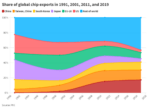How AI will transform manufacturing
-Robert Le Busque, Regional Vice-President, Asia Pacific, Verizon Business In Australia, the rapid development of artificial intelligence (AI) has coincided with the Government’s announcement of the $15 billion National Reconstruction Fund (NRF), $1 billion of which will be dedicated to reinvigorating, accelerating, and building up advanced manufacturing capabilities. As businesses have already started adopting AI for various use cases, the Government has also recently launched a public consultation to seek advice on how to mitigate any potential risks and ensure it is applied responsibly. One of these uses cases is advanced manufacturing, which is a broad term that encompasses technologies applied to any manufacturing facility, including application software and AI tools to augment and generate higher value manufacturing output. Advanced manufacturing is also likely to use AI to embed faster and safer means of production and better operations management for industrial processes. Generating speed, safety and enhanced production Part of removing human error to make manufacturing safer and faster means reducing reliance on human observation. As machinery drivers and operators are among the top three occupation groups with the highest rate of work-related injuries in Australia at 6.5 percent in the 2021-2022 financial year, this makes a use case for AI analytics in augmenting workplace health and safety. High precision tracking, for example, detects faults in machinery micro-components at a scale previously unachievable – this improves productivity, output, and profitability for manufacturing companies. AI analytics can match workers’ physical position in relation to how they interact with machines, particularly heavy industrial machinery, facilitating a more comprehensive understanding of safety in workplace operations and injury. AI software can also manage workflows more effectively by identifying and allocating tasks. This can be taken one step further, with large site and heavy industrial manufacturing operations using digital twins to optimise these workflows – […]









